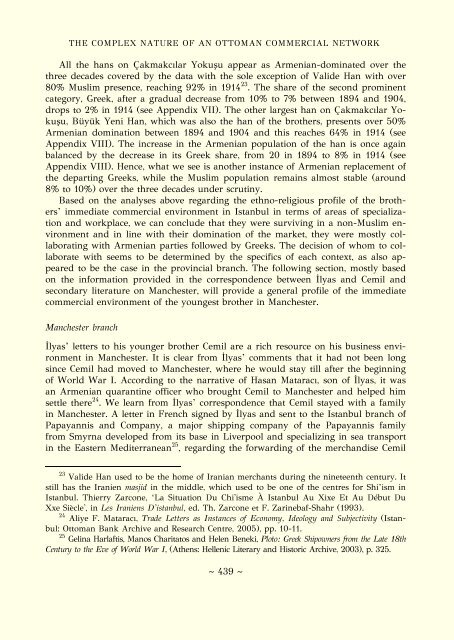You also want an ePaper? Increase the reach of your titles
YUMPU automatically turns print PDFs into web optimized ePapers that Google loves.
THE COMPLEX NATURE OF AN OTTOMAN COMMERCIAL NETWORK<br />
All the hans on Çakmakcılar Yokuşu appear as Armenian-dominated over the<br />
three decades covered by the data with the sole exception of Valide Han with over<br />
80% Muslim presence, reaching 92% in 1914 23 . The share of the second prominent<br />
category, Greek, after a gradual decrease from 10% to 7% between 1894 and 1904,<br />
drops to 2% in 1914 (see Appendix VII). The other largest han on Çakmakcılar Yokuşu,<br />
Büyük Yeni Han, which was also the han of the brothers, presents over 50%<br />
Armenian domination between 1894 and 1904 and this reaches 64% in 1914 (see<br />
Appendix VIII). The increase in the Armenian population of the han is once again<br />
balanced by the decrease in its Greek share, from 20 in 1894 to 8% in 1914 (see<br />
Appendix VIII). Hence, what we see is another instance of Armenian replacement of<br />
the departing Greeks, while the Muslim population remains almost stable (around<br />
8% to 10%) over the three decades under scrutiny.<br />
Based on the analyses above regarding the ethno-religious profile of the brothers’<br />
immediate commercial environment in Istanbul in terms of areas of specialization<br />
and workplace, we can conclude that they were surviving in a non-Muslim environment<br />
and in line with their domination of the market, they were mostly collaborating<br />
with Armenian parties followed by Greeks. The decision of whom to collaborate<br />
with seems to be determined by the specifics of each context, as also appeared<br />
to be the case in the provincial branch. The following section, mostly based<br />
on the information provided in the correspondence between İlyas and Cemil and<br />
secondary literature on Manchester, will provide a general profile of the immediate<br />
commercial environment of the youngest brother in Manchester.<br />
Manchester branch<br />
İlyas’ letters to his younger brother Cemil are a rich resource on his business environment<br />
in Manchester. It is clear from İlyas’ comments that it had not been long<br />
since Cemil had moved to Manchester, where he would stay till after the beginning<br />
of World War I. According to the narrative of Hasan Mataracı, son of İlyas, it was<br />
an Armenian quarantine officer who brought Cemil to Manchester and helped him<br />
settle there 24 . We learn from İlyas’ correspondence that Cemil stayed with a family<br />
in Manchester. A letter in French signed by İlyas and sent to the Istanbul branch of<br />
Papayannis and Company, a major shipping company of the Papayannis family<br />
from Smyrna developed from its base in Liverpool and specializing in sea transport<br />
in the Eastern Mediterranean 25 , regarding the forwarding of the merchandise Cemil<br />
23 Valide Han used to be the home of Iranian merchants during the nineteenth century. It<br />
still has the Iranien masjid in the middle, which used to be one of the centres for Shi’ism in<br />
Istanbul. Thierry Zarcone, ‘La Situation Du Chi'isme À Istanbul Au Xixe Et Au Début Du<br />
Xxe Siècle', in Les Iraniens D'istanbul, ed. Th. Zarcone et F. Zarinebaf-Shahr (1993).<br />
24 Aliye F. Mataracı, Trade Letters as Instances of Economy, Ideology and Subjectivity (Istanbul:<br />
Ottoman Bank Archive and Research Centre, 2005), pp. 10-11.<br />
25 Gelina Harlaftis, Manos Charitatos and Helen Beneki, Ploto: Greek Shipowners from the Late 18th<br />
Century to the Eve of World War I, (Athens: Hellenic Literary and Historic Archive, 2003), p. 325.<br />
~ 439 ~



